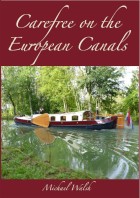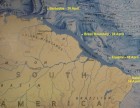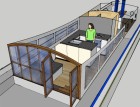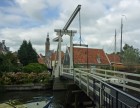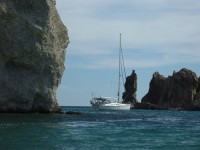Sequitur
Michael & Edi have headed out on a slow, thorough exploration of the globe.
| Vessel Name: | Sequitur and Zonder Zorg |
| Vessel Make/Model: | 2007 Hunter 49 and 1908 Wildschut Skûtsje |
| Hailing Port: | Vancouver, Canada |
| Crew: | Michael Walsh & Edi Gelin |
| About: | For our current location click, on Map & Tracking, then on the Google Earth logo. |
| Extra: | Follow us on Twitter: Follow @YachtSequitur |
| Social: |
13 January 2014
Another New Book Released
I am delighted to announce that my new book: Carefree on the European Canals is now in print and is available on Amazon.com, Amazon.ca [...]
26 April 2013
New Book Released
The proof copy of my new book arrived by courier today. I have approved it and it is now listed on Amazon for pre-order, with a publication date of 30 April. It is a rather large book at 680 pages in an 8.5 by 11 inch format with 315,000 words illustrated by over 2400 colour photos, charts and maps. [...]
24 April 2013
One Year Out of Brazil
One year ago today we sailed Sequitur out of Brazil after enduring more than six weeks in the least-friendly country that we had experienced during our three-year voyage. In the early evening of 24 April 2012 we crossed the line on the chart dividing Brazil from French Guyana and breathed a huge sigh [...]
27 October 2012 | Harlingen, Friesland
Planing a Metamorphosis
We have added a new post to the Zonder Zorg blog at: Planing a Metamorphosis.
29 September 2012 | Sneek, Netherlands
Onward to Friesland
We have arrived in Friesland and have added a new post to the skûtsje's blog at: Onward to Friesland
19 September 2012 | Hoorn, Netherlands
North From Aalsmeer
We have moved northward from Aalsmeer and I have added two new posts: Heading North From Aalsmeer and North From Amsterdam
13 September 2012 | Aalsmeer, Netherlands
Taking Possession
We are back in the Netherlands, and I have added some new posts to the ZonderZorg blog at: Taking Possession and Settling-In and Making Plans
20 August 2012 | Sequitur: St Augustine, USA - Michael & Edi: Vancouver, Canada - Nieuwe Zorg: Aalsmeer, Netherlands
Added a New Website
We have added a new website: Skûtsje ZonderZorg. Zonder zorg in Dutch means without worry. Our intention with the site is to provide a place to share some of the history, geography and culture of the skûtsje as we discover it. We will also use this place to document [...]
11 August 2012 | Sequitur: St Augustine, USA - Michael & Edi: Vancouver, Canada - Nieuwe Zorg: Aalsmeer, Netherlands
Still More Skûtsje History
We continued to attempt to track-down Douwe Albert Visser, who was the owner of Nieuwe Zorg in 1941 when she was re-registered. One of the problems we repeatedly encountered in our online searches was the effect of currently having Albert Visser and two Douwe Vissers as very competitive skûtsje racers, [...]
10 August 2012 | Sequitur: St Augustine, USA - Michael & Edi: Vancouver, Canada - Nieuwe Zorg: Aalsmeer, Netherlands
Some More Skûtsje History
While I was researching the history of Nieuwe Zorg, I finally found her first registration details obscured by an apparent typographical error in a transcribed online spreadsheet. She was listed as having been built in 1901 instead of 1908. I emailed the webmaster of the [...]
Edi’s Back in La Punta
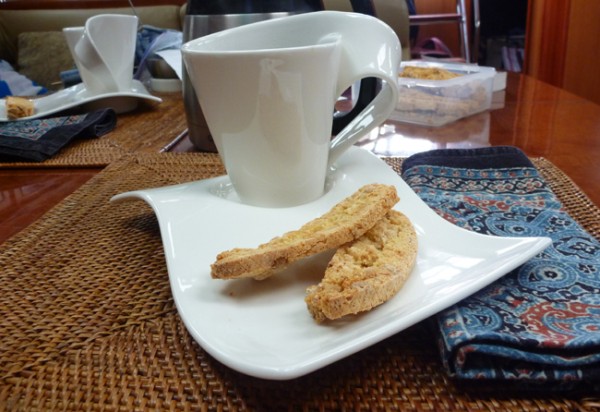

We were up at this unusual hour so that we could catch a launch ashore to join Pamela & Michael of Precious Metal and Patti & Mark of Alpha Wave in a couple of taxis for the hour-or-so drive to Miraflores to rendezvous with Gonzalo. From there we were driven south along the coast some 300 kilometres to Ica, where we were splendidly hosted at Bodegas Vista Alegre by owner Rafael Picasso Salinas. We spent a superb time touring, tasting and dining. The day was so full of wonderful experiences that we have decided to devote an entire blog post to it: Bodegas Vista Alegre

Edi and I arrived back onboard Sequitur from our day in Ica shortly before midnight. We slept-in on Sunday and had a late-morning breakfast of toasted freshly- imported bagels with Peruvian Queso Crema and Peruvian coffee. In the early afternoon I sorted through all of the things Edi had brought back in her luggage. In addition to the biscotti and bagels, there were many kilos of our favourite 72% dark chocolate, a few kilos of asiago cheese, bags of dried blueberries and several other edible niceties not available here. To feed the sewing machine, Edi had brought in several metres of cordura nylon, ultra suede and other locally unobtainable materials.

There was also 15 metres of 3/0 tinned wire, weighting 16 kilograms, eight 3/0 cable terminals, four screw-post battery terminals and four Racor fuel filters that Edi had tracked-down with the friendly assistance of Peter Johnston at River Marine. Peter had gone out of his way to provide her with quick and accurate service at very low prices. This is such a refreshing change from the high prices, the lack of service, the lack of concern, the long order delays and the other frustrations we have experienced with the two major marine retailers in Vancouver. We now have most of the pieces that I need to install the second alternator.

On Friday afternoon as I was heading out the gate with the garbage, the guard in the caseta had called me over to tell me that a package had arrived for Sequitur. The spare assembly and the repair kit for the Lewmar engine control had finally arrived after three weeks in the mail. Taking-up almost the entire back of the package was a Customs declaration in Spanish printed in huge font on letter-sized paper. The Google translation that I had sent the shipper seems to have worked as I had hoped it would; the package had made it through Customs without duties and taxes. The declaration read the Spanish equivalent of: "Repair parts for Canadian sailboat in transit. Parts will not remain in Peru. No value for Customs."
My next hope was that I would be able to examine the new mechanism and determine what was amiss with the broken one. To this point, I had not been able to locate repair sheets, engineering drawings, or any other piece of guidance to help me. By ordering the whole new mechanism and the repair kit, I was hoping that I would be able to easily spot the problem and use some of the repair kit to fix it, leaving us with a new spare. If not, then I would swap the old mechanism with the new and be left with a broken spare and a repair kit to try set it right.

I donned my spelunking kit and tunnelled into the dark and cramped spaces aft of the port cockpit settee locker, managing to gash my head only once on a protruding bolt end. The space is so cramped that it is very difficult to get a proper look at the mechanism. After more than an hour of repeatedly twisting body joints, scraping skin, craning neck and seemingly extending eyeballs beyond their sockets, I had done sufficient examining, comparing, thinking, re-examining, re-comparing and re-thinking, to have finally figured-out what was wrong with the mechanism.

I had discovered that the stainless clip had bent and sprung off two of the four retaining lugs, and it was no longer holding the sheath of the shift cable. This allowed the sheath to move with the cable and rendered the transmission linkage ineffective. I replaced the clip after only forty-five minutes of manoeuvring my body and teaching my left elbow how to bend backwards and my fingers to grow a couple of centimetres and develop double articulated joints. I ran the engine and tested the transmission. We once again have mobility. For the first time since we left Paita in early June, I can shift forward and astern without having to go down to the engine space and push or pull the transmission lever.
On Monday we went ashore by launch and caught a taxi to Maestro on Argentina to look for, among other things, some spacers that I needed to continue with the installation of the alternator. We found the proper ones and we also bought a telescoping pole, designed for paint rollers. We had been looking for boathook handles to attach to the three boathook ends we had brought from Vancouver, and this was the best we had seen in the many times we had been out searching. We had no luck; however, in finding metric hardware, and we need to keep searching for some stainless 6mm lock washers. We walked along the two blocks to Minka and had lunch in a small chifa, before we bought some fresh fruit and vegetables and a kilo of eggs.

On Tuesday we took a bus along La Marina to San Miguel and went shopping at Sodimac and Tottus. Among other things, I bought a 100 Watt soldering gun so that I can solder the connectors to the ends of the 3/0 wire. I could not find any large gauge crimpers, and will need to continue looking. We also bought some groceries and fresh produce, and picked-out a nice-looking fillet of perico. In the evening I prepared the fish in a brown butter sauce and served it with basmati rice and a julienne of carrots, onions and red and green peppers, garnished with Roma tomatoes. The accompanying Gato Negro Sauvignon Blanc did not justify its price.
On Wednesday I went into the starboard transom locker to begin the process of repairing the autopilot. My analysis of the symptoms had concluded that the drive motor had not been properly installed by the yard in Vancouver during our fit-out. We had begun receiving intermittent "Lost Drive" error messages on the autopilot screen in late December, while we were at Isla Espiritu Santo in the Sea of Cortez.
As the problem worsened through January, and after I had eliminated electronic causes, I had discovered that the drive motor was hanging at the ends of its mounting bolts. It had apparently been hung there with the lead portion of its splines mated, but it had not been tightened up into place to fully engage the splines. I immediately tightened the drive motor up into its proper place, and the autopilot began working again. The damage had been done; however, and within two months the "Lost Drive" error began to recur with each new spell of heavy seas. By spring, the autopilot had ceased to function even in the calmest of seas.


Now it was time to see if my analysis had been correct. I dismounted the drive and shot a series of photos, some with grease still in place and some with the grease wiped away to reveal the damage and some of an undamaged unit. The Service Manager at Specialty Yachts in Vancouver, the yard that had done our fit-out, arranged to have Lewmar send some used parts for me to use to try to do a repair. In comparing the splines on the installed drive with those on the used, but undamaged drive, it is obvious that my analysis was correct. There are two distinct levels of wear; the first up to the point to which the loose splines would have reached, and the second the remainder of the splines that would have been engaged after the drive had been properly tightened home.

I could not easily get my head into position to see the male splines, so I manoeuvred the camera into position and shot some photos. Thankfully, the male splines appeared to be made of harder steel, and they showed only minor damage, some rounding and flattening at their ends. I need now to locate a heavy-duty 8mm hex wrench so that I can disassemble the drive motor and replace the end unit and its damaged splines with the spare. Then I will see if I can mount those replaced female splines onto the existing male splines without having to do any machining. If I can, it will save me all the work of removing and replacing the T bevel drive.

Late on Wednesday afternoon I went ashore and met Richard, and with him drove to Miraflores for the weekly meeting of Sociadad Numismatica del Peru. I was warmly received by the group as a Past President of the Royal Canadian Numismatic Association, and I told the small gathering that Richard is our only member in South America, and that I couldn't pass through Lima without a visit to them.

I had a delightful evening, discussing some of the different aspects of coin grading between our two countries, learning about the fascination of collecting Peruvian coppers and a myriad other numismatic topics. There were thirteen of us at the meeting, and I was presented with a very nice example of the 1925 Sole as a memento of my visit.

After much discussion, some trading and a small auction, ten of us drove across town to a private club above the cliffs in Miraflores, and there we sat in a private gaming room playing a round of dudo, a local dice game. About half an hour into the game a waiter came in with menus and took our dinner orders, and we continued rolling dice for another half hour or so. By the time we had finished the game, and had made our way up to the dining room, our dinners were ready. This is the regular weekly routine of the society, and I found it very civilized when compared to the monthly meeting routine of most Canadian coin clubs. Richard drove me back to La Punta, and I was back aboard Sequitur shortly after 0100.

On Thursday Edi and I continued with little projects aimed at getting Sequitur ready for continuing south. Edi tried-out the new Brother sewing machine for the first time onboard, as she made-up ultra suede covers for some of the cockpit throw cushions. The machine is rated at 70 Watts, so it was a very minor draw on the battery, never demanding as much as 5 amps while I watched the gauge. Mid-afternoon we made a run ashore to the pier to get water, and while we were there we paused for some ceviche and cervesa on the upper deck.

On Friday morning we went ashore and walked the three kilometres or so to an area we had been told has a lot of marine hardware stores. We criss-crossed the area, we asked for directions, and all we could find were suppliers of commercial fishing supplies and very heavy marine goods. No one we asked knew of any source for stainless steel hardware or pleasure yacht supplies. We then walked back to Callao's version of 2nd of May Avenue and caught a bus headed to La Marina.
We got off at Plaza San Miguel and walked across to Maestro, where the only metric hex wrenches we could find came as half of a 26-piece set of US and metric. We bought it, plus an articulated mirror on an extendable wand and an assortment of nuts, bolts and washers. We then continued across to Wong, where we bought another eight kilos of flour and half a dozen bottles of wine in our continuing process of re-stocking Sequitur. For our current consumption we also bought some pork loin and some fresh produce, including portobello mushrooms, plus an assortment of cheeses and some breads.
On Sunday morning we made a run ashore to get water, and then shortly before noon we took the launch ashore again to meet Gonzalo. He had kindly offered to drive us around to try and find a replacement for our stolen dinghy. We drove the twenty-or-so kilometres to Miraflores, and stopped at Aquasport. We are looking for an inflatable in the 3.0 to 3.5 metre range, and they had only one in stock of that size, a Korean-built no-name. It looked well-built; but unfortunately, it was made of PVC, not Hypalon.

We learned that Aquasport manufactures a line of inflatables locally with imported materials, including Hypalon. Among the sizes they build is a 3.3 metre, which is available as either a fibreglass hulled RIB or as a slatted aluminium-floored roll-up. Their delivery time from order is two weeks. With Gonzalo's assistance, we had the Corporate Sales Consultant, Melissa Cuadros Montalvo write-up a quote for both models, the RIB at US$4,500 and the roll-up at US$2,200.
We then drove to the Regatta Club in Chorrillos. This is a very large and modern private sports club, founded in 1875, and Gonzalo had arranged to meet a fellow there who had some used inflatables, but we couldn't locate him. After making a phone call, Gonzalo said he would arrive around 1500, and suggested we have lunch while waiting.

Gonzallo asked if we liked Japanese, and from our enthusiastic response, he took us to Itamae, a Japanese fusion restaurant on the beachfront within the club compound. We started with some superb ahi sashimi, followed by an assortment of wonderfully creative rolls and finished with a platter of shellfish and vegetables. We spent a delightful hour sharing broad-ranging conversation and outstanding food. Gonzalo would not allow us to pay for the lunch, lamely insisting that since we were not members, we could not pay.

On our way back to meet the fellow with the used dinghies, we passed some Inca terns, beautiful medium-sized birds with red feet and red beaks and distinctive white moustaches. Their range is restricted to where the Humboldt Current meets the coasts of Peru and Chile, and these were the first examples we had seen.
The fellow with the dinghies had not shown-up, so after Gonzalo had made another phone call, we piled into his car and chased back up the cliffs and into Miraflores to the fellow's boatyard. What he had were not suitable; either too large or too used. Gonzalo drove us back to La Punta, and then had to drive all the way back to Miraflores and rush to get ready for a family wedding in the early evening. We continue to receive such outstanding hospitality here in Peru.

